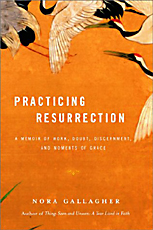"When I think about the resurrection now, I don't only think about what happened to Jesus. I think about what happened to his disciples. Something happened to them, too. They went into hiding after the crucifixion but after the resurrection appearances, they walked back out into the world. They became braver and stronger; they visited strangers, and healed the sick. It was not just what they saw when they saw Jesus, or how they saw it, but what was set free in them.
"If there is some kind of life after death, what if it's not a life exclusively for the dead? What if it's a life available to us all, something the living can participate in, too? Just after someone has died, this life sometimes becomes briefly and intensely visible and what? Inhabitable? 'The barrier between . . . two worlds grows very thin,' said Stephen Vernay, a British writer who lost his wife to cancer. But then, Vernay added, 'The appearances have to give way to something more important still, which is that we too can come alive . . . a new pattern of events is set free to happen around us.'
"We spend so much time in the church 'believing' in the resurrection or 'not believing' (six impossible things before breakfast) that we may lose the point. What if the resurrection is not about the appearances of Jesus alone but also about what those appearances pointed to, what they asked? And it is finally what we do with them that matters-make them into superstitions or use them as stepping stones to new life. We have to practice resurrection."
